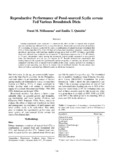Reproductive performance of pond-sourced Scylla serrata fed various broodstock diets

Tingnan/
Request this document
Petsa
1999Page views
250Metadata
Ipakita ang buong tala ng item
Share
Abstract
Feeding experiments were conducted to determine the effect of diet on reproduction of pond-sourced unablated and ablated Scylla serrrata broodstock. Broodstock were fed either natural food (T1) consisting of mussel, squid, fish by-catch, a combination of natural food and formulated diet (T2), or formulated diet (T3). After 120 days of culture, best broodstock response in terms of total spawnings, spawnings with hatchings, number of eggs per g body wt (BW) of female, egg fertilisation rate, and total zoea produced was obtained in T2 and poorest response was in T1. Broodstock in T3 gave intermediate values among the treatments. Larval quality measured as zoea growth index and broodstock survival was also highest in T2. Results showed that combination diet feeding improves the reproductive performance and larval quality of unablated and ablated females compared with those fed on natural food or artificial diet alone. Latency period from stocking to maturation and spawning was shorter in ablated than in unablated females. Rematurations were observed both in unablated and ablated females in all dietary treatments.
Suggested Citation
Millamena, O. M., & Quinitio, E. T. (1999). Reproductive performance of pond-sourced Scylla serrata fed various broodstock diets. In C. P. Keenan & A. Blackshaw (Eds.), Mud crab aquaculture and biology: proceedings of an international scientific forum held in Darwin, Australia, 21-24 April 1997 (pp. 114–117). Canberra: Australian Centre for International Agricultural Research.
